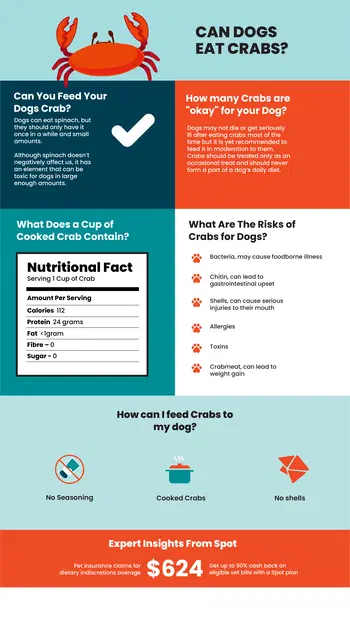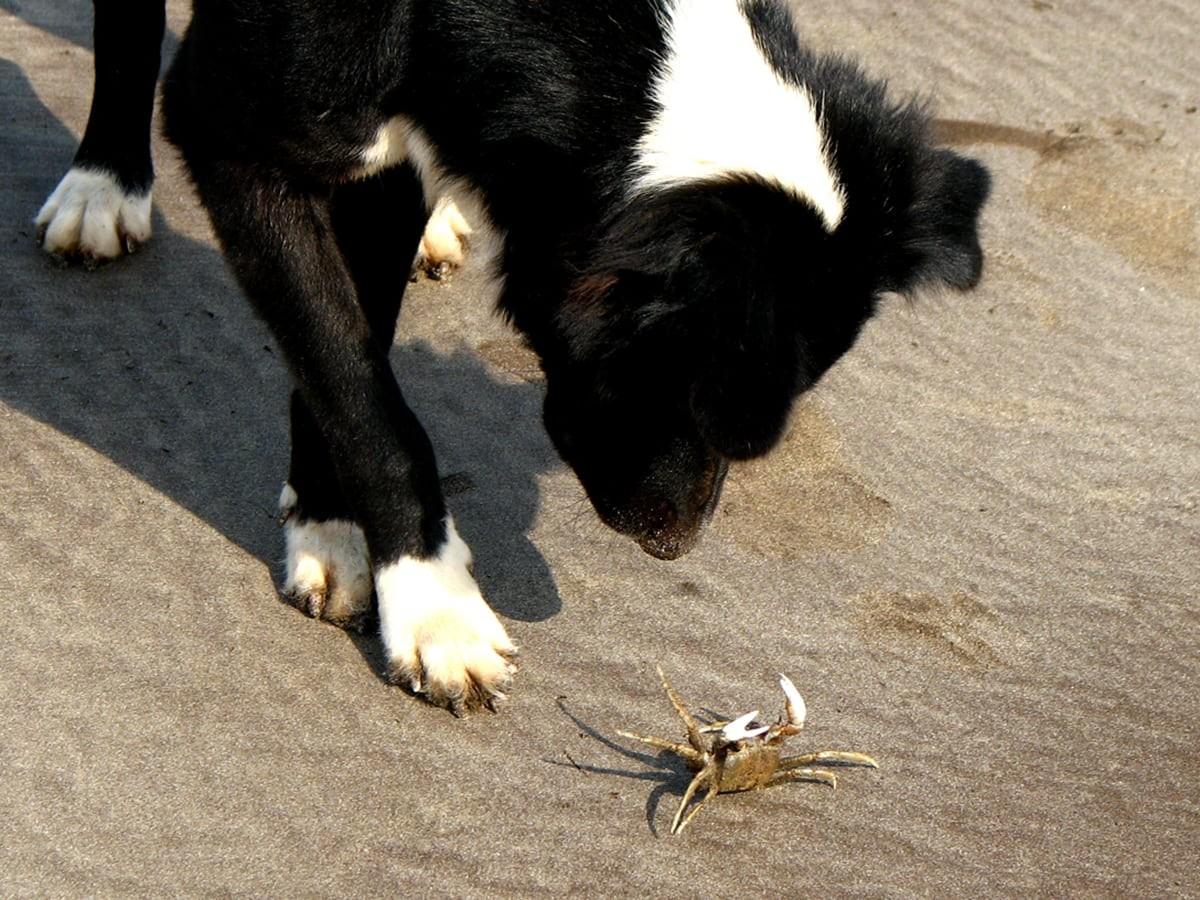Can You Feed Your Dogs Crab?
Feeding crabs to dogs is generally safe but there are many precautions that you need to take beforehand and acceptable ways in which you need to serve it you need to know.1 So, before going ahead and offering a plate of crabs to your dog, there are some more questions you should be asking like how many crabs are okay for your dog to have and what are the precautions to take while feeding these crabs to it. And we will answer them all.
Creatures that first appeared during the Jurassic Period, crabs are unique. They are known for their ability to regenerate lost limbs through a process called autonomy. These creatures have become a popular seafood delicacy across the world. With types like Dungeness, Horseshoe, King, Peekytoe, Snow, Rock Crab, etc. they have found a place in various culinary preparations.
Dogs are omnivorous. So, crabs could be a safe food to eat for them. Or is it? The first question to ask here would be -
Do Dogs Like Crabs?
Dogs are curious creatures, especially about the foods that their humans are eating. So, there is a possibility that if you are eating a crab, your dog may start staring at you and maybe even bark asking for a bite. But before offering, you will have to first know…
Are Crabs Good for Dogs?
A cup of cooked crab would contain the following –2
Calories – 112
Protein – 24 grams
Fat – <1gram
Fibre – 0
Sugar - 0
Apart from these, crab meat can be an excellent source of Vitamin B12, folate, iron, niacin, selenium, and zinc. The protein helps in muscle growth and repair. The vitamins help in nerve function, the formation of red blood cells, build immunity and improve vision. Minerals like phosphorus, zinc, copper, and selenium play important roles in bone health, immune function and antioxidant defence. Blur crabs also contain Omega 3 fatty acids that are beneficial for the heart and help reduce inflammation in the body. And all of this with a low fat and no sugar content.
Looking at this list it may feel like if these crabs are a superfood for humans, it would be the same for Dogs. But a thing to understand here is that the biology of both of us is different; meaning the way we extract nutrients from food may not be the same as how Dogs do. Hence the next question -
What Are The Health Benefits of Crabs for Dogs?
While the benefits for humans and dogs are not the same, crabs do provide some benefits to dogs as well.
Vitamin B12 helps them in improving their brain function.
The proteins, omega-3 fatty acids, and amino acids support their skin, nails, and connective tissue.
The benefits are limited here and on the other hand, the risks outweigh them.
What Are The Risks of Crabs for Dogs?
Bacteria – Bacteria such as Vibrio, Salmonella, and E. coli, that maybe present in crabs may cause foodborne illness in dogs leading to an upset stomach causing symptoms like vomiting, diarrhea, fever, and lethargy.
Chitin – It is a complex carbohydrate which dogs find very difficult to digest. It can later lead to gastrointestinal upset including symptoms like vomiting, diarrhea, and abdominal pain.
Shells – Crabs have sharp shells, which if ingested by dogs, can cause serious injuries to their mouth, throat and digestive tract. Swallowing these fragments can even lead to lacerations, blockages, and even internal damage
Allergies – Some dogs may be allergic to crabs or certain components found in crabs. Allergic reactions like skin rashes, itching, swelling, and difficulty breathing may trigger for them.
Toxins – Some, not all, crabs contain certain toxins which can be harmful t dogs and can harm their nervous system causing symptoms like seizures, tremors, and paralysis.
Crabmeat is also high in sodium and cholesterol content, which can lead to weight gain in dogs.3
Expert Insights From Spot
While sharing our favorite foods with our pets can be tempting, it's important to remember that not all human foods are safe for dogs. Spot's internal data shows that pet insurance claims for dietary indiscretions average $642*, highlighting the importance of caution and research before sharing snacks with your pet.
How Many Crabs Are "Okay" for Your Dog?
Dogs may not die or get seriously ill after eating crabs most of the time but it is yet recommended to feed it in moderation to them. Crabs should be treated only as an occasional treat and should never form a part of a dog’s daily diet.
How Can I Feed Crabs To My Dog?
It is important to know how exactly to feed Crabs to your dog. The rules to remember here are as follows –
Plain – Avoid the buttery crab legs and cakes or any kind of seasoning on top of it like garlic or onions especially. They can cause additional health hazards for them.
Cooked – Raw crabs can cause a choking hazard and digestive issues for the dog. Cooked crabs make it easier for digestion. Raw crabs may also contain intestinal parasites that can affect a dog’s digestive tract.3
No shells – Crab legs and shells, as mentioned above, can be very harmful to your dog. Make sure you remove them before feeding.
What Else Can Your Dog Eat?
Our furry friends are notorious for eating whatever they want, whenever they want. Unfortunately for them, they don’t know when they’re getting into something potentially dangerous, and sometimes neither do we. It helps to know which foods are toxic to our dogs so we can understand when they could be in trouble. Sometimes the treat we enjoy is just as beneficial to our dogs. Here are some healthy snack choices that you can securely and moderately incorporate into their diet.

Seafood Your Dog Can Eat
Dogs can safely consume seafood. If they eat shellfish like lobster, their shells, legs, and tails should be removed to avoid the possibility of puncturing their internal organs. Dogs can also eat fin fish, like salmon, shrimp, and some tuna (in moderation) if their bones are removed for the same reason. Your dog might benefit from staying away from canned tuna if it comes in a package filled with salt water or contains any extra salt. Likewise, seafood given to dogs should not be seasoned at all.
Seafood can have bacteria and other toxic elements in it when they’re undercooked. Because of this, seafood should always be thoroughly cleaned and cooked before it’s offered to your dog.
Fruits Your Dog Can Eat
Several fruits are healthy favorites for dogs and provide a nutritional treat and supplement in their diet. For example, dogs love bananas. Bananas are a great source of potassium and vitamins. Dogs can have many kinds of melons, like watermelon, plus kiwis, oranges, apples (without the core, seeds, or stems), pineapples, and mangos. Fruits that are packed with antioxidants like blueberries, strawberries, and raspberries are very healthy for dogs when they’re offered in chunks and thoroughly cleaned.
Grapes, raisins, and sultanas are poisonous to your dog and shouldn’t be eaten at all. Cherries and other fruits with pits, like peaches, plums, and the like, are not considered safe either. The flesh of the fruits is safe to eat, but pits are hazards and poisonous. You should always take the pits out of fruits before giving them to them. Here is a full list of fruits your dog can eat.
Vegetables Your Dog Can Eat
Eating onions, leeks, and garlic could be lethal for your dog. Seasonings that contain these ingredients could be just as deadly, which is why it’s a good idea to avoid them. There are some other veggies that you can feed your dog during safe snack time. Dogs can have carrots, spinach, green beans, and pumpkin safely. Furthermore, they can eat kale, broccoli, and brussels sprouts, and they are all completely safe and actually very healthy for them. Sometimes too many veggies can cause gas, so pay attention to how much vegetables can dogs eat in one sitting.
Beans Your Dog Can Eat
Beans are packed with important nutrients for a dog’s diet. Dogs can have lima beans, black beans, garbanzo, pinto, kidney, soy, and butter beans, too. Feeding your dog too many beans could cause them to have gas. To avoid an upset stomach, only give them beans in moderation.
Nuts Your Dog Can Eat
Some nuts should be completely avoided, like macadamia nuts and walnuts. These are very poisonous to dogs. Fiber and potassium may be the only nutritional benefits of nuts, and there are many other safer ways for dogs to receive these nutrients. However, If they’re begging for a treat, they can eat pistachios and peanuts in moderation without posing a threat. Nuts should never be seasoned or shelled. Here is a full list of all the dry fruits your dog can eat.
Final Thoughts
What different seafood can your dog eat? The great news is that your dog can eat any number of different kinds of seafood. They can eat lobster, crab, shrimp (when properly cooked), and a litany of different types of fish.
As always, it is better to consult with your vet before making any dietary changes. They can help you determine whether changing course is the right idea and what might be best for your pooch. Crab can be a delicious treat for your dog and a welcome addition to their diet.

As Spot’s resident cat enthusiast, I am dedicated to researching and sharing information that helps pet owners take the best care of their pets. Pet ownership comes with it’s share of challenges, but my goal is to help make this journey easier.
*Jan 2019 to Aug 2024 administrator claims data.
“Can Dogs Eat Crab Meat? The Surprising Risks.” Sundays, n.d., sundaysfordogs.com/blog/can-dogs-eat-crab-meat-the-surprising-risks.
“Crab: Are There Health Benefits?” WebMD, 09 Mar. 2023, www.webmd.com/diet/health-benefits-crab.
"Can Dogs Eat Crab?" Purina, 10 Jul. 2024, https://www.purina.com/articles/dog/feeding/can-dogs-eat/crab.
The information presented in this article is for educational and informational purposes only and does not constitute or substitute for the advice of your veterinarian.












